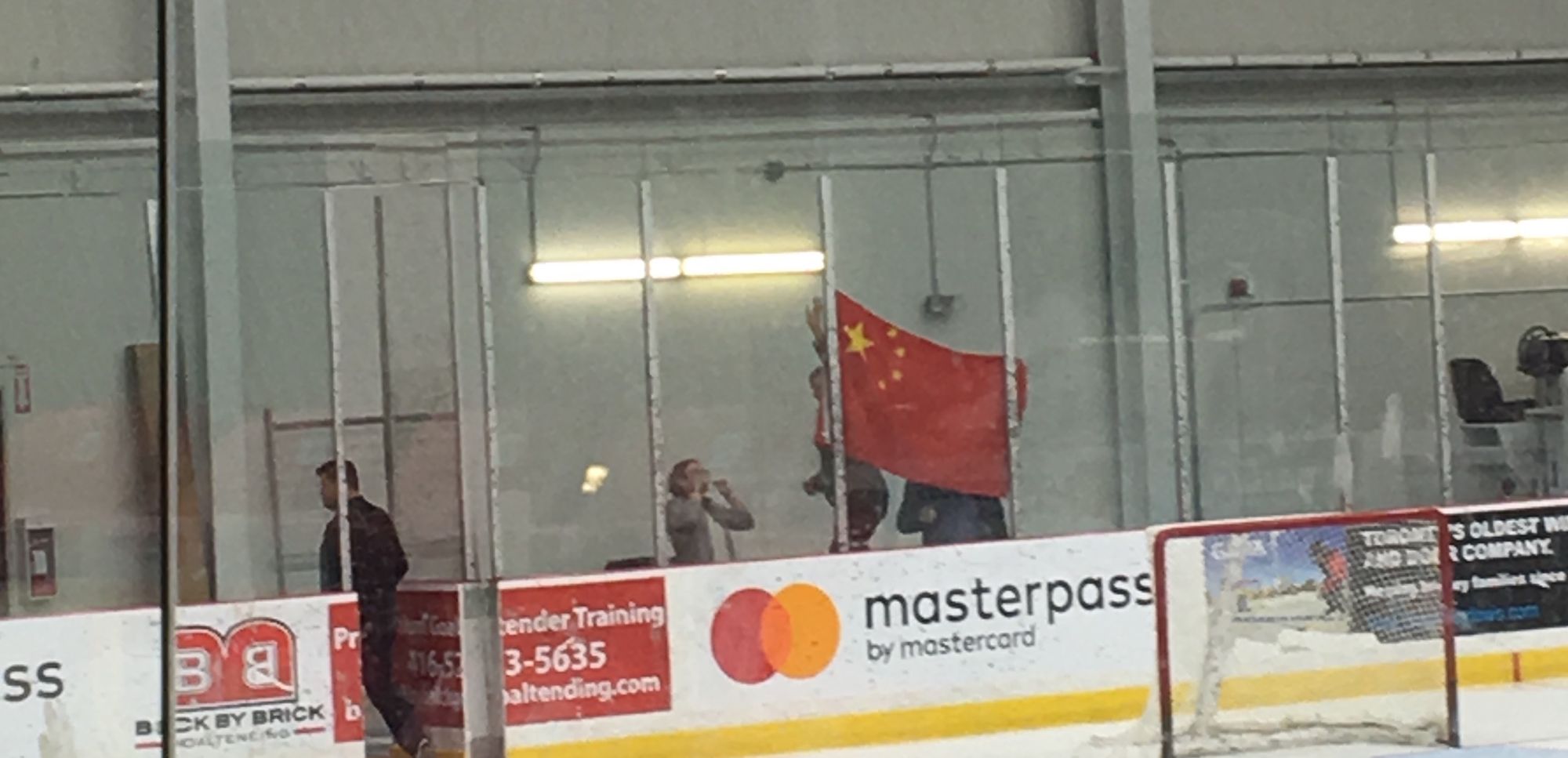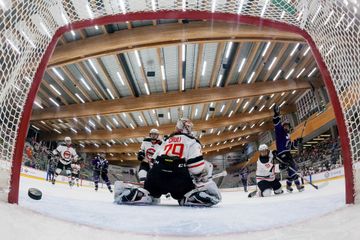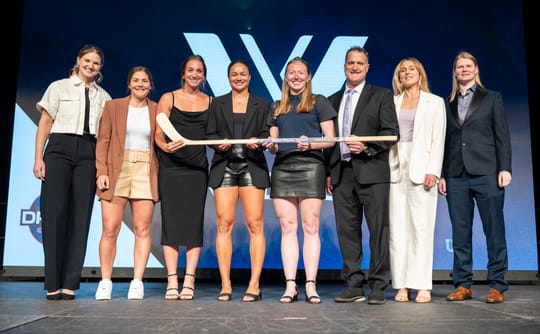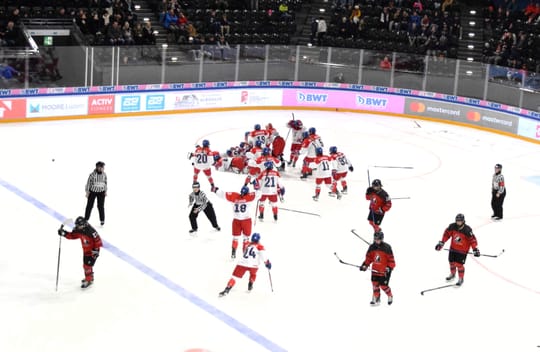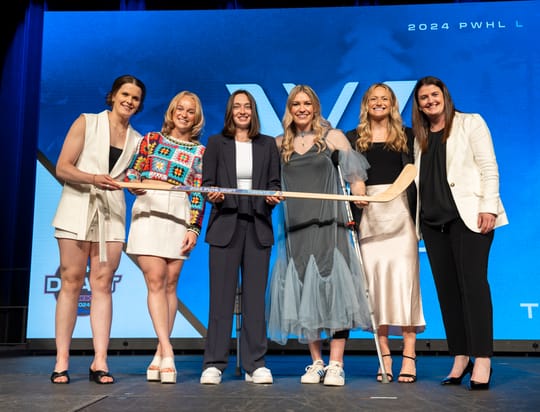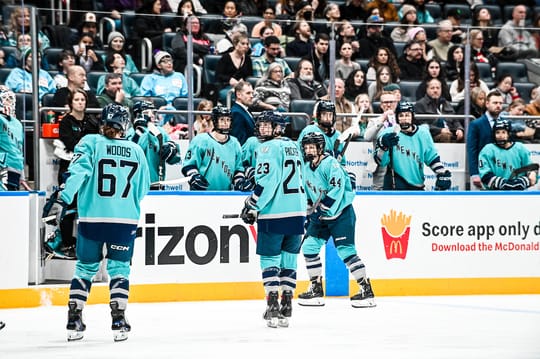Harbin (哈尔滨) is the most populous city in Northeast China. It's the coldest major Chinese city, and is known for its Ice and Snow Festival. Nearly every native player in the Chinese women's ice hockey national team development program comes from Harbin or Qiqihar (齐齐哈尔), which is about 300 kilometers northwest of Harbin. Until 2017, Harbin was ground zero for the Chinese national women's ice hockey team. They trained there and employed staff there, while players competed on two privately-owned club teams, one each based in Harbin and Qiqihar.
In summer 2017, the program was completely shut down and staff were unceremoniously dismissed. The Chinese women's national team's training program now belongs to the KHL's Kunlun Red Star organization, and has abruptly moved over 3300 kilometers south to Shenzhen (深圳), where the Canadian Women's Hockey League (backed by Kunlun Red Star and the KHL) is basing two new women's teams: Kunlun Red Star and Vanke Rays. Shenzhen has a warm, subtropical climate and not a lot of history with ice hockey. The CWHL teams both play at the Shenzhen Dayun Arena, which has a capacity of up to 18,000 spectators -- an extremely large facility in a country where ice hockey attendance for the biggest tournaments often numbers in the hundreds at best.
The two clubs are rostered with many professional women's players from North America and Europe, as well as some native Chinese players who played in the old program and who were hoping to make the 2022 Olympic team.
All of this was done with the pretense that the CWHL and KHL would be working together with the Chinese government and the Chinese Ice Hockey Association to "grow the game" in China and put together a competitive women's team before the 2022 Winter Olympics in Beijing, when China will receive an automatic qualification. While China has been in the mix for qualification before, they have never qualified directly for an Olympics and haven't been in the Olympic tournament since 2010.
Micah (not his real name) spoke to the Victory Press via Skype about what happened over the summer. He is a coach who previously worked with the developmental squad of 19- and 20-year-old female players in China.
Micah described a strange series of events that led to a sudden press conference where Digit Murphy was effectively announced as the new head coach of the Chinese national women's ice hockey team, a position that she does not currently actually hold. (Instead, she is the head coach of Kunlun Red Star.) "Working in China, you get used to things being sprung on you at the very last minute. We were at practice one day, and our team leader said to us, 'Oh, just stay behind after practice, you need to get measured up for your suits.' We were like, why are we being given suits? ...'Oh, it's for the press conference!'"
At the press conference, the rink where they had been practicing for several months in Harbin had been decked out in Kunlun Red Star colors and logos. "And it looked great, to be fair," Micah says. "We get called aside by the team leader at the door to this press conference, and he said, 'Listen, I need to tell you this. It's a big press conference, they're going to announce that this woman is the new head coach of the program. But she's not the new head coach of the program, don't worry about it, we don't really know what's going on -- they've just called this meeting, but it's fine, there's nothing wrong with your jobs.'"
After the surprise press event in February of 2017, Micah says everything continued normally for a few months. In April, everyone working for CIHA was due to have a month of vacation.
"After a month, we start sending emails, like oh, when are we coming back?" Micah remembers. "They're like, 'oh we don't know yet, just hang on.' And this rolled on and on and on."
While they continued to receive paychecks, they were kept totally in the dark about what was happening with the program. Micah was not told that his contract to work with the CIHA had been cancelled until he showed up in person four months later at their offices in Beijing.
"Essentially, the entire program -- the national program, all of our development program, ceased to exist," Micah says. "We had to sign to cancel our contracts. And it was then picked up by the KHL [and] Kunlun Red Star."
One player from the development program, Zhang Chi, 20, said in an interview over WeChat that she started playing hockey when she was eight years old, and originally got involved in the sport "for fitness." Zhang Chi also goes by Ashley (most players in the women's Chinese ice hockey program have also picked English names). She plays professionally for the team in Qiqihar, now as an adult player.
However, when Kunlun Red Star took over, they required all of the players who wanted a chance to compete on the national team to register for the CWHL draft. Harbin's professional team released its players from their contracts (which, according to sources, pay reasonable living wages), but the owner of Qiqihar's team did not. The players remain with the team in Qiqihar, though they no longer have anyone to play competitively against in China. When the Victory Press spoke to Ashley in December, her club team was traveling in Japan to play friendlies against professional teams there.
Players like Ashley were recruited into the national development program from a very young age, and were taken out of formal education to play hockey and train full time. But because Ashley was not released from her contract in Qiqihar, she is no longer involved or even potentially involved in the national team program.
Those who have worked closely with the development system in China criticize its handling of young players. While players have been training for a long time, veterans of western hockey development programs feel that their training is deficient and repetitive, and doesn't build necessary skills.
"They are driven into the ground with how much training they do," Micah says. "It's just phenomenal what they make them do -- that they forego education to do this. [They] get paid a reasonable amount, but not anything groundbreaking."
Developing as a good hockey player is a lifelong process. "It takes 20 years, not five," says Mark Simon, a Canadian development consultant who has worked in Chinese ice hockey for over a decade. He spoke to the Victory Press in December 2017 in a Skype interview. Mark has remained in China with a personal mission to improve the experience for youth players there. "It's just not a very sustainable system. That's why kids all quit when they're 12, basically," he says.
The stunted development of Chinese ice hockey is a problem that pre-dates both the KHL's arrival on the scene and Beijing's Olympic bid, according to Mark. He works with parents of youth players on a regular basis who have felt that something is wrong with the system for years now.
"You know, the Olympics and all of this, it's kind of a bit of a distraction to be honest, because it's sort of taken the attention away from the problems with hockey," he says. He feels that the focus on preparing a team for 2022 has become a singular focus, rather than creating a hockey program in China that is self-sustaining. "That's fine, but what about the kids in 2023 or 2024, and forever? ...For me, that's a bigger need and should be a bigger priority for China."
Andre (not his real name) is another Canadian who has been working in Chinese youth ice hockey for many years, who spoke in an interview via WeChat. He is currently managing hockey operations for a Beijing-based hockey club. "When I first arrived, most hockey was played in the northern winter regions -- Harbin, Qiqihar. But now it is everywhere; Beijing, Shanghai and a lot of clubs," he says. "I believe there are more than 30 clubs in Beijing alone, playing out of 30 different rinks, [including] players from 4 [to] 15 years old."
Andre thinks that despite the growth, problems in the sport stem from a lack of regulation and resources. "There is no structure for coaching, no coaching levels, no resources for the coach, like we have in Canada and [the] USA! The internet here is limited, controlled by the government, so coaches can't get online to download or to look at coaching information, drills, etc." he says. Andre spoke to a lack of even internal training for coaches. In Canada, even a coach for a team of 5-year-olds needs to have a certain amount of training and certification. "The [refereeing], that is another aspect of the game that needs improving," he added. "[There are also] no levels or courses for [officiating], no one overseeing, educating, or evaluating officials. I believe this will all change if China decides to compete at the highest levels in ice hockey."
In Mark Simon's experience, most kids quit hockey before heading to high school because by that point, the game has been ruined for them. They've been given innumerable one-on-one lessons by coaches that are boring and repetitive. He also recounts that many kids are subject to physical abuse by coaches as common practice. The youth league competition is mercurial and unpleasant, and about half the games are blowouts, so kids are either suffering crushing defeats with few takeaways or winning by huge margins that don't feel challenging. Andre's hockey club recently hosted a large national tournament with teams from 15 different provinces in China. There were some games that were close, with scores like 3-2, but other games had huge 15-0 margins.
"In a proper system, where a kid is developing in a healthy way... the parent and kid would possibly be in love with the game -- like 'Oh, we're not quitting, we can't quit!' Because this [would be] so valuable," he says. "You're learning possibly another language, you're learning about another culture, you're learning about teamwork, you're learning about cooperation, you're becoming a better person on top of becoming a better player." But this is not the current reality of youth hockey in China. Most kids are done before they have a chance to play a truly competitive game.
South Korea will compete in Olympic ice hockey for the first time in 2018, having been automatically granted qualification as the host nation, like China will in 2022. In order to try and compete, they have used a common strategy to fill out their rosters. A few years before the Games, they started bringing non-native Koreans in to try out for the women's national team -- players from North America with at least one native Korean parent, and, in one case, a player who had been adopted from South Korea: Marissa Brandt.
Marissa is competing using her birth name, Park Yoon-Jung. Other players who made the move to South Korea to become eligible citizens and compete in the Olympics did not get as much press -- Park Yoon-Jung likely does because her sister, Hannah, played Division I hockey for Minnesota and is a prominent member of the United States National Team. Marissa Brandt played Division III hockey in the US. When she moved to Korea in 2015, she instantly became one of the best hockey players in the country.
The history of naturalizing foreign-born players in order to pad a country's Olympic roster is as long as that of the modern Olympiad. In 1908, the first Olympic national teams were born.
"For most of the 20th century, it just meant that occasionally a country weak in a certain sport would attempt to recruit athletes from another country who had some sort of dual citizenship. For example, 90% of the [Great Britain] ice hockey team in 1936 were raised in Canada, though born in the UK," said Hilary Evans, an Olympic historian and member of the International Society of Olympic Historians. "Very occasionally, athletes who were in the process of naturalization had their applications speeded [sic] along slightly to ensure they were completed in time."
However, recruiting has become more aggressive in recent years, with some sports and nations being more affected than others. Sometimes, money is even exchanged between nations as a direct payoff, if rumors are to be believed; Qatar is said to have paid Bulgaria the equivalent of US$1 million for a handball player around the year 2000.
The potential for the abuse of transfers seems enormous. The Olympics may seem like an enormous, monolithic organization, but in reality, eligibility for the Olympics is determined by the international governing body of each sport that is included. The International Olympic Committee may make judgment calls related to the inclusion of certain sports and the eligibility of certain athletes, but it isn't within their purview to stop international transfers that are sanctioned by a sport's governing body, as well as by the countries involved. The International Association of Athletics Federations, which oversees track and field events worldwide, froze all international transfers during the year of 2017, hoping to establish entirely new regulations to stop potential abuse of the system.
Because of the technicalities of eligibility involved, bringing in players from elsewhere who might be able to meet your nation's legal requirements for citizenship requires several years of advance planning, or more. Koreans obtaining citizenship by naturalization can decide to not renounce their previous nationality based on a provision for those of "outstanding talent" -- so players like Marissa Brandt who have reconnected with Korea can still keep their previous citizenship, in addition to being naturalized Koreans. This makes the naturalization process pretty straightforward, and while players being interviewed about their experience in Korea expressed some amount of culture shock, articles like one from USA Today in June 2017 depict a program that is hoping to begin a new era for South Korea in ice hockey through development.
In addition, it has been announced that North and South Korea will ice a unified women's ice hockey team and march under a unified banner in the Olympics. Realistically, South Korea won't medal in women's ice hockey. But while this show of unity between South Korea, North Korea, and Korean-Americans and -Canadians is an outstanding outcome, regardless of how many goals they manage to score in the tournament, it's possible that this unification will come at the expense of some talent on the South Korean roster.
All of these things -- transfer rules, money changing hands, rosters changing to incorporate import players -- could affect how China's women's ice hockey roster takes shape.
Multiple unconfirmed rumors have suggested that the price paid to the CWHL by the KHL's Kunlun Red Star investor in China, Billy Ngok, is in the tens of millions of dollars, and that this sum was to be split evenly among the five pre-existing CWHL teams in North America. The reported and rumored salaries for the Kunlun Red Star and Vanke Rays players and coaches in China are in excess of that. Despite the lack of confirmed figures, a significant amount of money has definitely changed hands to make these teams a reality. Purportedly the money given was to finance travel to China for the North American teams, but it also coincided with the first salary payments to North America-based CWHL players. This much is confirmed on the record by CWHL commissioner Brenda Andress. But to what end? Is it sustainable? Is it intended to be? (The CWHL did not answer a request for comment regarding the investment made by Billy Ngok into their program, or regarding their plans for long-term sustainability in China.)
It is important to remember that there are some cultural differences between China and North America that may make this sudden decision seem odd to North American hockey personnel. Micah recounted that he had difficulty adjusting to doing business in China, where decisions are made very quickly and on the fly. In his current coaching job, he often does not know where he will be living for weeks at a time. "We are traveling to Beijing in 10 days' time," he said during our interview in December of 2017. "We don't know if we are coming back to [our current city] to live for three months or if we're gonna live in Beijing after that. We're going to find out in Beijing where we're gonna live."
This isn't considered a problem in his organization, though it might seem odd to an outsider. But consider the big-picture implications of a quick business decision that affects the entire sport. Billy Ngok is a single investor now bankrolling a major CWHL expansion and the entire ice hockey development program of China. He's an individual billionaire who might suddenly change his mind about the CWHL, or about Shenzhen, or about ice hockey...or he might simply run out of money between now and 2022. It is not a group of individuals cooperatively working in China to sustain the CWHL teams and the ice hockey program -- it's one guy, whose other financial interests primarily involve energy investing and whose associates are primarily other energy investors from Russia. A Globe and Mail article from 2016 stated that Kunlun Red Star, then a KHL club entering its second season, was already trying to figure out how to financially deal with its losses. The KHL team is Ngok's primary venture in Chinese hockey.
Mark Simon doesn't necessarily think that bringing in outside help is a bad thing for Chinese ice hockey. Applying knowledge from programs in Russia, Canada, and the United States could truly inspire a strong ice hockey program in China, if it is done correctly. But currently, the focus is on quickly filling gaps at the senior level with imported players, rather than revolutionizing and enhancing the current youth and development programs. "Bringing in that kind of hockey expertise with the group that they've been able to put together -- it's not a bad thing. It's not like it's bad," Mark says. "It's just, it's not at all attacking the problems on the ground. It's only attacking the problems at the top."
For Mark, the question is whether or not it's worth it to gut the development program on the ground just in order to bring in athletes from abroad who will not make the team the best in the world anytime soon. We will see this play out in Korea in just a few weeks' time. "They'll get them to maybe number 16 or 17 in the world -- fantastic! -- but why go through the trouble, why do all this, if that's as high as you're gonna get?" says Mark of the Korean men's national team, as an example. "In sacrificing those spots on the team and compromising kids within your program who are Koreans. What about the 2050 Olympics? You can't just keep putting bandaids on stuff."
The sustainable future of Chinese ice hockey long-term likely needs to include kids from the northern reaches of the country, but it will also likely include players like Yan Huang, a forward who also goes by Angel and plays for the Kunlun Red Star U18 team. Angel recently played in the IIHF Women's U18 Worlds in Division I Group B, notching 2 assists and 13 shots on goal in 5 games. Her team came out of that tournament ranked 4th. Their handiest win was against the British team (4-1), but they finished the tournament with a thrilling OT win against Austria.
Angel hails from Shanghai and is one of the players that Mark Simon has coached. He says that her place in the sport is "unique", as she's one of the few native Chinese players with the national team who doesn't come from the north. Growing up in Shanghai is very different from growing up in Harbin -- you learn English, for example, and it's comparatively multicultural. It makes it way easier, Mark says, to make it over to the States or Canada to train in a more advanced hockey program. Girls playing in the north, whose English skills are poor and who have often dropped out of school to play hockey, are unable to transition to a boarding school hockey program in North America.
Angel wanted to learn to skate when she was seven years old, and had a friend who traveled to Canada and saw hockey being played outside. Their first skating coach was a former Chinese national team player, who recognized the game when her friend came back to China and demonstrated. "[My coach said] 'that's hockey... If you guys are interested in hockey, I can coach you, but you have to get at least three kids together, then I can open the hockey lessons,'" Angel recounts.
Now 17, Angel says that her favorite thing about playing hockey is teamwork. "I think teamwork is the most important thing," she says, "and I really enjoy working together with my teammates." Her experience with the Kunlun Red Star U18 team has been positive. She feels it has improved her development as an athlete. "The way [we train is] much more professional now," she says.
But it remains to be seen how effective the Kunlun Red Star U18 girls' team will be in preparing native Chinese players for the Olympics. Already, players who preceded them in the national development program are seeing their hockey careers effectively end, even though they are only around 20 years old. Both Kunlun Red Star and the Vanke Rays do not always give them significant ice time, and both teams carry up to six foreign import players per league rules (with an exception for goaltenders, who do not count against that total), including the surprise US Olympic team cut Alex Carpenter.
But the U18 team is still comprised mostly of native Chinese players, and they are playing against very good competition in the Eastern Women's Hockey Conference in New England, where they won one division game in 2017. The girls on that team will likely see some personal improvement, and may well advance to the level expected of them if they want to play on the national team come 2022. But without a strong youth program in China itself, the number of players who are ready to compete at an international, elite level may plateau pretty quickly -- and fizzle out completely after the 2022 Games.
In one case, a Canadian player of Chinese descent may decide to naturalize and join the Chinese national team. Jessica Wong, an extremely skilled CWHL defender from Nova Scotia, joined Kunlun Red Star this fall. The Chinese government does not allow for dual citizenship like South Korea does, and typically requires people who become Chinese citizens to completely renounce their previous citizenships. "There's people that are dealing with that and I don't have to worry about it, so it's nice that way. We'll just take it day-by-day and let that handle itself," she said of Chinese citizenship when asked on November 2, 2017 in a postgame interview. The government may begin to make exceptions for players like Wong before 2022, but because of the citizenship issue, rounding out the Chinese roster with skilled players who are not already Chinese citizens may prove to be a contentious and lengthy process.
Since the Chinese Ice Hockey Association is effectively no longer operating a senior or junior developmental program for women, the short-term and long-term future of women's ice hockey (and hockey in general) in China depends heavily on how well the CWHL and the KHL support the current athletes, as well as youth programs in the country, rather than on their short-term success with import players. The CWHL has not answered a request for comment about what plans, if any, they have for supporting and improving youth hockey in China.
Currently, most youth hockey teams and classes are operated by rink owners, and the Chinese Ice Hockey Association is not overseeing or standardizing youth hockey programs around China. This leads to inconsistency at best, and at worst, abusive behaviors by coaches and rink operators that go unchecked. This can include excessive training and kids actually being beaten by their coaches.
The path forward, according to everyone interviewed for this article, has to include better youth hockey programs -- which should first and foremost be fun, and not abusive. Once you get kids coming back to hockey and loving hockey, then you can start thinking about keeping them in China longer to develop. Mark Simon says that as it is right now, if a player wanted to develop as a hockey player capable of playing at the elite international level, they must leave China by the age of 10 to join a North American program. "Or else they're doomed," he says. "You can't change someone from the age of 15. The damage is done. You've developed someone in a bad program for 10 or 12 years."
Andre, the hockey operations manager in Beijing, has seen that hockey is really exploding in popularity in China, and feels that the CIHA will have to step up to fill the gaps. "I just see there [are] not enough people working for the CIHA to cover all aspects at the moment," he says. "Youth hockey has really taken off and I believe they were not ready for this demand."
The first time a kid puts on hockey skates in China is a long way from when that kid pulls on a national team jersey. The CWHL's promise to women's hockey in China needs to include that first time on the ice and have a game plan for sustainability at the senior level until 2022 and beyond. The old CIHA program in Harbin and Qiqihar may not have been robust or even necessarily good or safe, but it was at least dedicated to the development of native Chinese players. If the CWHL program hopes to actually grow the game of ice hockey in China, then it needs to be mindful of what was wrong before they came onto the scene, as well as the vacuum that could be left if they were to leave.
Kirsten Whelan contributed reporting to this story. Editing by Nicole Haase and Mary Van Tyne.
